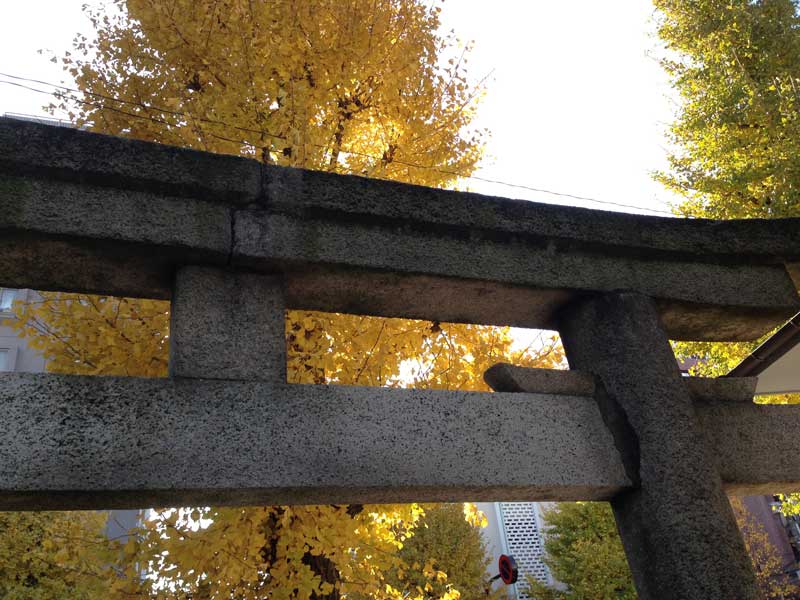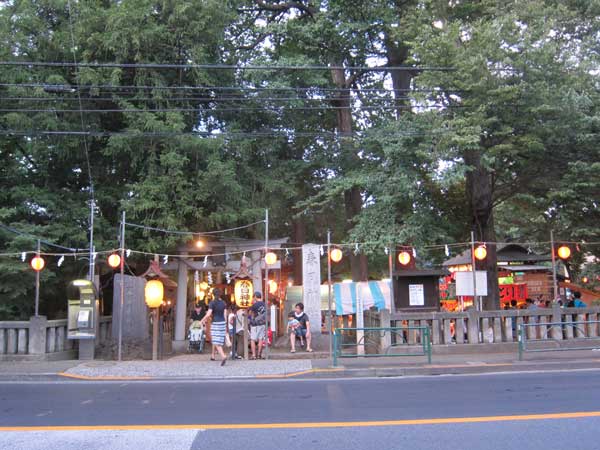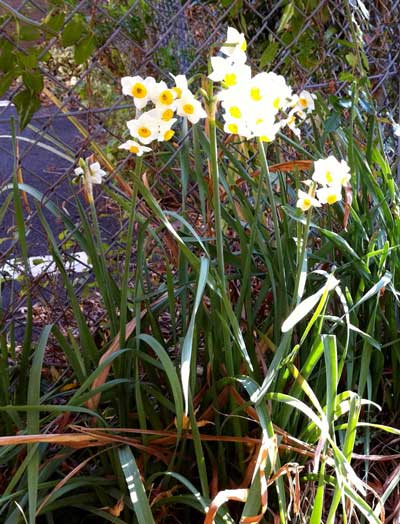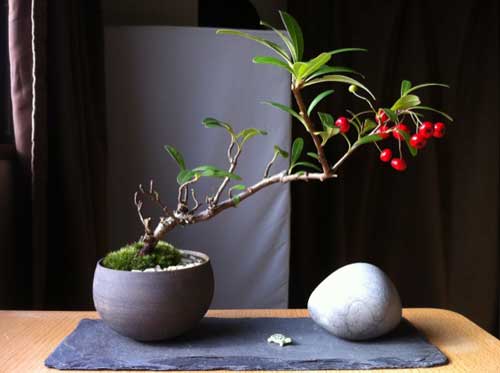
One of my favorite Japanese fall flowers is “leopard plant,” called tsuwabuki (ツワブキ) in Japanese. Many traditional gardens use it, and it looks like it could be growing wild by the stream.

The kilometers of mature gingkos lining Omeikaido make this wide and busy boulevard much more enjoyable. The yellow leaves are now, of course, all gone. But since I am posting more film photographs, I want to share some of my favorite fall photos that were recently developed. Fallen gingko leaves, school uniforms, umbrellas, face masks, and a slow-moving sidewalk bike are a perfect urban scene.

I stopped at the local shrine today to offer thanks for my visa renewal. The gate and the ginkgo leaves made me stop.

Because fall remained warm in Tokyo, the fall foliage extended all the way to the end of the year. The last few leaves are dropping now. Here’s the view from entrance to the Tokyo Metropolitan Gymnasium out towards Shinjuku Gyoen, the elevated freeway, and the Sendagaya station.

この柿の木は史火陶芸教室の裏庭で育っています。二年に一回、果物がたくさん出来ますが、多くない年もたくさんとれます。毎年、義理の母が生徒さんや友だちに果物と果物で作った料理をあげます。秋は柿です。夏はユスラ梅です。東京は、果物の木が多いことを知っている外国人が少ないです。
Many foreigners are surprised just how full of persimmons Tokyo is in the fall. Maybe you’d miss them if you stick to inside the newest malls and corporate developments. But it must be one of the most popular residential trees, and a true marker of fall.
This one is behind Shiho ceramic studio, and the funny story is that my in law teachers say that this year there aren’t so many fruit. Despite being an off year in a two year cycle, there’s actually still quite a lot of fruit. My mother in law is a great cook, and she uses these fall persimmons and also small sour plums in summer for food she shares with students and friends. She didn’t plant these trees but has gotten a lot of use from them in the past ten years.
Some persimmon trees produce fruit that’s best eaten raw, others dried, or cooked into jam or other sweets. For me it’s an acquired taste, but seeing these orange globes dangling across Tokyo is undeniably beautiful.


コスモスは東京の秋の花だと知っていますか。近所の花店で買った。今庭で、ピンクや濃い青や白や黄色の花が多いです。ブルーベリーの葉は紅葉になります。
Did you know that cosmos are a fall flower in Tokyo? You see them everywhere this time of year, so I picked up this one from my neighborhood flower shop. This fall my garden has a lot of pink (roses, fujibakama), deep blue (Okinawa morning glory, lavendar, salvia), and white and yellow (pansies, marigold, geranium). The blueberry bush leaves are also turning red and gold.
 スカイラインの上に、濃い青色の琉球朝顔が咲いています。東京の秋の日はきれいです。
スカイラインの上に、濃い青色の琉球朝顔が咲いています。東京の秋の日はきれいです。
Fall is beautiful in Tokyo.

突然、ベランダのミントに紫色の花がたくさん咲きました。午後遅くの日光に、葉は金と赤い色になります。秋の瞬間です。
My mint is suddenly full of purple flowers. And in the late afternoon sunlight, the leaves turn gold and red. It’s a fall moment.
I love having herbs on my city balcony: for cooking, for scent, and for variety. Mint is ridiculously easy to grow, and I hope the seeds travel and plant themselves somewhere nearby.

西東京の9月の祭りは、旧街道の住民を繋げます。御神輿やお盆踊りや神社の祭りは地元の神を見えるようにします。秋の祭りも町の人々に農業の周期を思い出させます。音楽や衣装や銀賞や踊りが大好きです。特別の料理、提灯、お年寄りや高校生が集まって、普通の公共空間が生き生きとしてきます。
One of my favorite times in Tokyo are the September festivals, with portable shrine carrying and yukata-clad dancing happening in small groups up and down the main roads that pre-date the west-bound Marunouchi subway and Chuo train line. These photos are from Ome Kaido and Itsukaiichi Kaido.
The fall festivals connect city life with agrarian traditions, and by bringing the shrines into the road they literally bring the local spirits into view. I like the music, the costumes, chanting and dancing. But also the festival food stalls, lanterns, and crowds of seniors and high schoolers.



秋の晴れた空に、富士山が見える。現実じゃないみたいです。
With the clear skies in fall, it’s easier to see Mount Fuji from Tokyo. It looks almost unreal.


There is something very pleasing about the small berries on Murasaki shikibu, named after the author and heroine of the famous 11 century novel The Tale of the Genji. Here they are still green, but soon they’ll turn purple.

I gave a minor trim to the kaede maple bonsai I made at Sinajina. It looks healthy. And the moss is even blooming. It’s now ready for fall.

一月は春夏秋冬が一度に見れる。これは友達の横浜のゲリラ・ガーデンです。咲いている水仙、大きな里芋の葉、 紅葉、明るいの冬空。
My friends John and Ruth McCreery sent me these wonderful photos of their guerrilla garden in Yokohama. The McCreery’s adopted a neglected patch of land between the road and the parking lot of their large residential complex. I like how they captured the odd feeling at New Year’s in the Tokyo region when you see plants typical of all four seasons all thriving. Plants that I recognize include large leafed taro, red maple leaves, and blooming daffodils.
Maybe nothing is more typically winter in Japan than the presence of all the other seasons!
Update: Later I received an email from Ruth explaining how the taro plant arrive in the garden unexpectedly:


友達が作った素敵な景色盆栽は秋を表現しています。それぞれの要素は色々な違う場所から来ています。
My friend’s stylish bonsai composition expresses autumn with elements from distant geographies.
My friend Matthew Puntigam created this bonsai composition last week. It’s a wonderful expression of late autumn: the red berries, sparse leaves, and asymmetry of the plant, and the intriguing composition that creates a fantasy landscape with elements from distant geographies.
The plant is, possibly, called ピラカンサス (pirakansasu) in Japanese, or Pyracanthas in Latin. I like how Matt, a bonsai apprentice, has paired the plant with a stone from Sadoshima (佐渡島), an island in Japan or Korean Sea, depending on your perspective, that served as a penal colony and place of forced exile since the eighth century. The diminutive turtle is of unknown provenance, but the slate is an old roof tile from Matt’s Maryland hometown.
Thank you for the gorgeous image!